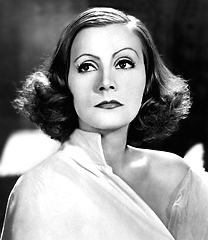|


Greta Garbo was born Greta Lovisa Gustafsson on September 18, 1905. Garbo was born in Stockholm
to poor parents. She went to work at age 14, first as a lather girl in a barbershop, then as a clerk in a department store
and as a model.
In her first motion picture, Luffar Petter (1922), she played a bathing beauty. From 1922 to 1924
she studied at the Royal Dramatic Theatre, Stockholm. During that period met Mauritz Stiller, the foremost Swedish director,
who gave her an important role in Gsta Berlings Saga (1924; "The Story of Gsta Berling"), gave her the stage name Greta Garbo,
and trained her in cinema-acting techniques.
In 1925, when Stiller went to the United States to work for Metro Goldwyn
Mayer, he insisted that Garbo be given a contract also. In all, she appeared in 27 films (two in Sweden, one in Germany, and
the remainder in Hollywood); the most important of her silent films were The Torrent (1926), Flesh and the Devil (1927) and
Love (1927), both with the popular leading man John Gilbert, whose name was linked with hers in a much-publicized romance.
Anna Christie (1930) was the talking picture in which her rich, low voice was first heard. It was a great success,
although Garbo herself despised her performance. It earned her the first of her four Academy Award nominations for best actress.
That same year, Garbo earned another Academy Award nomination for her role in Romance.
Garbo was her most seductive
playing the WWI spy in Mata Hari (1932). So much so that the censors complained of the revealing outfit shown on the movie
poster. Her next film that year was Grand Hotel, with one of the first all star casts. The film earned MGM its second Best
Picture Oscar.
After almost 2 years off the screen, Garbo signed a new MGM contract granting her almost total control
over her films. She exercised that control by getting leading man Laurence Olivier fired from her film, Queen Christina (1934),
and forcing Mayer to replace him with former co-star and lover John Gilbert, whos career had faltered since the coming of
sound.
In 1935, David O. Selznick wanted Garbo cast as the dying heiress in Dark Victory, but she insisted on a screen
version of Leo Tolstoy's classic novel, Anna Karenina. She had already starred in a silent version, Love (1927), with John
Gilbert.
Many have called Garbo's performance as the doomed coutesan in Camille (1937) the finest ever recorded on
film. Some fans even claimed that during the star's climatic death scene they saw her soul leave her body. Not surprisingly,
this role earned her a third Academy Award nomination.
Director Ernst Lubitschs finest work of the 1930s was the classic
Ninotchka (1939). It starred Garboin a comedy! "Garbo Laughs" said the advertisements. And she does, charmingly. Ninotchka
earned Garbo the last of her four Academy Award nominations.
At age 36, after the flop of her film, Two Faced Woman
(1941), Garbo withdrew from the entertainment field and retired to a secluded life in New York City. In 1954 she was awarded
a special Academy Award for unforgettable performances.
Garbo died on April 15, 1990, in New York, N.Y. She was one
of the most glamorous and popular stars of the motion pictures of the 1920s and '30s.
Garbo had, in the opinion of
her directors and most critics, a perfect instinct for doing the right thing before the camera. Her talent, her great beauty,
and her indifference to public opinion made her career unique in the history of the cinema.
|